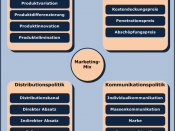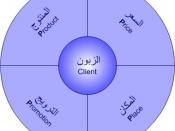There are four elements to the marketing mix. These four elements consist of product, place, price and promotion, also referred to as the ÃÂfour PÃÂsÃÂ. All elements are just as equally important in contributing to the marketing success of any company. Technology Assurance Group, also known as TAG National is an organization that utilizes the marketing mix to remain a profitable organization. They currently have 117 members across the United States and Canada.
ÃÂTechnology Assurance Group (TAG) is a national organization of leading independently owned telecommunications companies located in the United States and CanadaÃÂ (Technology Assurance Group, 2003-2008). TAG NationalÃÂs target market is a telecommunications company that current sells over $1 million in products annually, has at least 10 employees, and is no closer than 100 miles to the nearest current TAG Member. Based on the size of the memberÃÂs marketplace, most territories are exclusive to that member. This greatly increases their competitive advantage and market dominance.
In larger metropolitan areas such as Los Angeles and Chicago, members enjoy geographical semi-exclusivity which dramatically limits the potential for conflict with a non TAG member competitor. This helps to eliminate having two competing members in the same area. The idea is that TAG will help its member become the most dominant company of its kind within its geographical area. Therefore, TAG is extremely selective in who they will accept as a member and who they will pursue.
ProductIn taking a look at the first element, product, it can best be described as either a good or service that satisfies the needs of a customer. Since TAG National is a member service-based organization in the telecommunications industry, they have no tangible product for sale. They provide services such as discounts on products, training for employees, and help in marketing their memberÃÂs businesses.
TAG forms strategic partnerships with many leading vendors across the country that are committed to providing the best quality, service, and customer satisfaction. By committing to these partnerships, TAG is able to pass on volume discounts to members on many products they already buy and also introduce them to the latest technology they may not be aware of. They currently have partnerships with 49 companies ranging anywhere from a company that provides web design to a video surveillance company.
They provide the telecommunication industry's most advanced sales, technical, management and financial education to their member companies, delivered live in seminars, in interactive remote training sessions and via webinars. The training sessions provided include the introduction of new and established technologies, assuring that the members can provide their customers with the most advanced information solutions available in the marketplace.
Most of TAGÃÂs members are small to mid-sized companies that cannot afford a marketing department. Many times they pay an outside source up to $3000 per month to help them with press releases and ads to promote their company. TAG takes the burden off of the member by aiding them with their marketing efforts at a very minimal cost. They help produce ads and press releases, send them to the right media contacts, and help train personnel on basic marketing functions that they can handle on their own.
PlaceThe second element, place, ÃÂis concerned with all the decisions involved in getting the ÃÂrightÃÂ product to the target marketÃÂs PlaceÃÂ (Perreault-McCarthy, 2004, p. 39). As stated earlier, TAG cannot have even two members in the same area as it would conflict with the whole basis of the organization. Since this is a service-based organization, there are no manufacturers, no stores, wholesalers, or retailers involved. The only distribution channel would be between the company and the prospective member in the right target market.
PriceThe third element, price, is the cost of the product or service charged by the seller to the customer. This price must be thought out carefully keeping in mind the competition, reactions of the customer to the price, and changes in prices due to discounts, bulk purchase, promotions and seasonal items. TAG National bases its monthly dues on the level of service the member would like to receive. Basic membership runs for $1500 per month and includes discounts to all TAGÃÂs negotiated strategic partnerships with vendors, rebates with those vendors based on volume of purchases, free monthly remote and webinar training, access to all standard documents and forms used in the industry, and participation in the C-TAP (Current Technology Assurance Plan) creating profits and lifelong customers.
Upgraded memberships are available that include optional services such as creative marketing for $250 per month where TAG is the marketing department for these small to mid-sized companies that cannot afford a full time team. Another upgrade is unlimited training to live sessions. Normally each live training session runs $500 per person. But for an upgrade in membership of $250 per month, the company is put on unlimited training and can send as many attendees as many times as they want. This pricing structure helps to give members the option of which services they need. Many times the companyÃÂs membership dues are covered because they receive so many rebates on products that the membership ends up ÃÂpaying for itselfÃÂ. A member can cancel their membership at any time, with a 30-day notice and never has to sign a long-term contract.
PromotionThe fourth element to the marketing mix is promotion. ÃÂPromotion represents the various aspects of marketing communication, that is, the communication of information about the product with the goal of generating a positive customer responseà(NetMBA.com, 2002-2007, ö 7). Promotion is sometimes referred to as advertising, and includes such things as coupons, television commercial ads, signs, free samples, and mass mailers. TAG National does not utilize any of these mediums but instead relies on referrals and personal selling. The service TAG provides would not benefit from mass selling since they need to be selective with regards to who they ÃÂsellàto. If they were to mass sell, such as a commercial or a mass mailer, they may get several calls and actually have to turn down many requests for membership. There are no tangible products to sell so they do not have the need for coupons or free samples. They do however, have an introductory package, as well as a website, that tells all about the benefits of the organization and what it can offer the potential member. Sales personnel for TAG seek out members and rely on personal selling to obtain members. ÃÂPersonal selling involves direct spoken communication between sellers and potential customersà(Perreault-McCarthy, 2004, p. 40). A sales person makes the call, informs the prospect of all the benefits of joining TAG, sends out the introductory package via Federal Express, and invites that member to join an upcoming sales class where TAG will pay all expenses. This is the most successful way new members are obtained. It gives the prospect a chance to hear all about the company in person, experience a sales training class first-hand, meet with TAG management, and meet with current members and hear testimonials from them.
ConclusionReferencesNetMBA.com. (2002-2007). The Marketing Mix (The Four PÃÂs of Marketing). Retrieved on January 4, 2008 at http://www.netmba.com/marketing/mix/Perreault, W. & McCarthy, Jr., J. (2004). Basic Marketing: A Global-Managerial Approach, 15e, The McGraw Hill Companies.
Technology Assurance Group. (2003-2008). Retrieved on January 5, 2008 from www.tagnational.com



Hmm!!
I dispute the validity of your grade... Information like this can be easily found in any book...
0 out of 1 people found this comment useful.